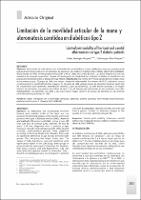| dc.contributor.author | Sisniegas-Vergara, César | |
| dc.contributor.author | Ríos-Vásquez, Carlomagno | |
| dc.date.accessioned | 2023-05-31T20:20:53Z | |
| dc.date.available | 2023-05-31T20:20:53Z | |
| dc.date.issued | 2020-02-26 | |
| dc.identifier.citation | Revista del Cuerpo Médico Hospital Nacional Almanzor Aguinaga Asenjo. 2019:12(4). | es_PE |
| dc.identifier.issn | 2227-4731 | |
| dc.identifier.uri | https://hdl.handle.net/20.500.12959/3806 | |
| dc.description.abstract | Objetivo: Determinar la relación entre la limitación de la movilidad articular (LMA) de la mano y la presencia de placas de ateroma en las arterias carótidas de pacientes con diabetes mellitus tipo 2 (DM2). Material y métodos: 80 pacientes con DM2, en dos grupos (40 con LMA y 40 sin LMA), entre 40 y 80 años. La LMA se diagnosticó con una maniobra de la plegaria positiva. Usando ultrasonografía en modo B de las arterias carótidas se clasificaron las placas ateromatosas según la Escala de Gray-Weale. Resultados: No existió diferencia significativa en edad y sexo entre ambos grupos. El grupo de LMA tuvo mayor tiempo de enfermedad. Los valores de VLDL colesterol, urea y creatinina fueron significativamente mayores en el grupo de LMA. Ambos grupos de pacientes tuvieron igual tipo de tratamiento para diabetes, hipertensión arterial y anti dislipidémico. La LMA estuvo asociada a un mayor número de ateromas. Las placas carotídeas de tipo I, II y III fueron más frecuentes en los pacientes con LMA. Conclusiones: los pacientes con DM2 y con LMA tienen mayor número de placas de ateroma en las arterias carótidas que los pacientes sin LMA. | es_PE |
| dc.description.abstract | Objetive: to determine the relationship between
limited joint mobility (LJM) of the hand and the
presence of atheroma plaques in the carotid arteries of
patients with type 2 diabetes mellitus (DM2). Material
and methods: 80 patients with DM2, in two groups (40
with LJM and 40 without LJM), between 40 and 80
years. LJM was diagnosed with a positive prayer
maneuver. Using B-mode ultrasonography of the carotid
arteries, atheromatous plaques were classified
according to the Gray-Weale Scale. Results: There was
no significant difference in age and sex between both
groups. The LJM group had longer illness time. The
values of VLDL cholesterol, urea and creatinine were
significantly higher in the LJM group. Both groups of
patients had the same type of treatment for diabetes,
high blood pressure and anti-dyslipidemic. LJM was
associated with a greater number of atheromas. Type I,
II and III carotid plaques were more frequent in patients with LJM. Conclusions: patients with DM2 and with LJM
have a greater number of atheroma plaques in the
carotid arteries than patients without LJM. | es_PE |
| dc.format | application/pdf | es_PE |
| dc.language.iso | spa | es_PE |
| dc.publisher | Seguro Social de Salud (EsSalud) | es_PE |
| dc.relation.uri | http://cmhnaaa.org.pe/ojs/index.php/rcmhnaaa/article/view/561 | es_PE |
| dc.rights | info:eu-repo/semantics/openAccess | es_PE |
| dc.rights.uri | https://creativecommons.org/licenses/by-nc-sa/4.0/ | es_PE |
| dc.subject | Limitación de la movilidad articular | es_PE |
| dc.subject | Ateroma | es_PE |
| dc.subject | Arteria carótida | es_PE |
| dc.subject | Enfermedad macrovascular | es_PE |
| dc.subject | Diabetes mellitus tipo 2 | es_PE |
| dc.subject | Limited joint mobility | es_PE |
| dc.subject | Atheroma | es_PE |
| dc.subject | Carotid artery | es_PE |
| dc.subject | Macrovascular disease | es_PE |
| dc.subject | Diabetes mellitus type 2 | es_PE |
| dc.title | Limitación de la movilidad articular de la mano y ateromatosis carotídea en diabéticos tipo 2 | es_PE |
| dc.title.alternative | Limited joint mobility of the hand and carotid atheromatosis in type 2 diabetic patients | es_PE |
| dc.type | info:eu-repo/semantics/article | es_PE |
| dc.subject.ocde | https://purl.org/pe-repo/ocde/ford#3.02.18 | es_PE |
| dc.identifier.doi | https://doi.org/10.35434/rcmhnaaa.2019.124.561 | |






